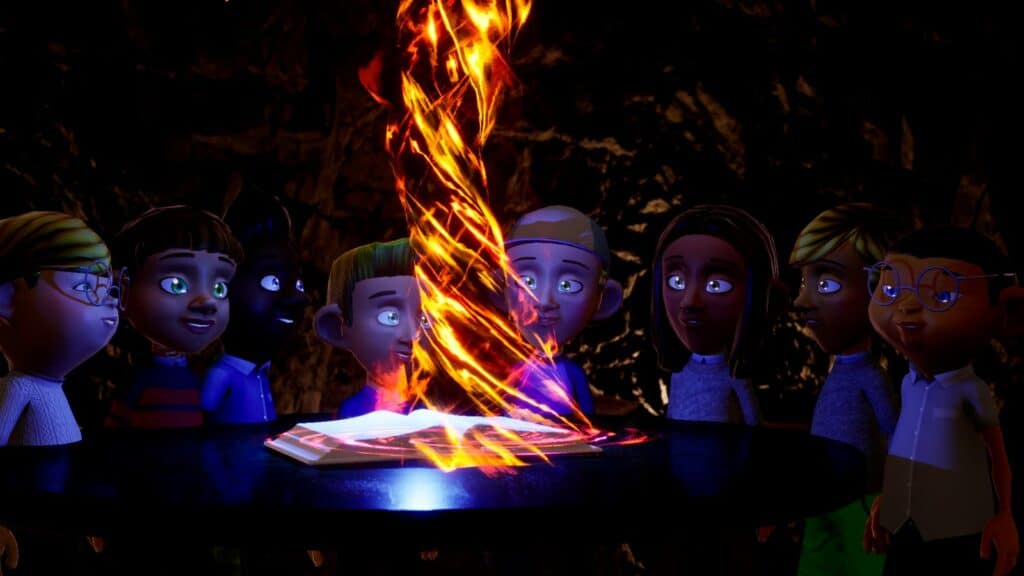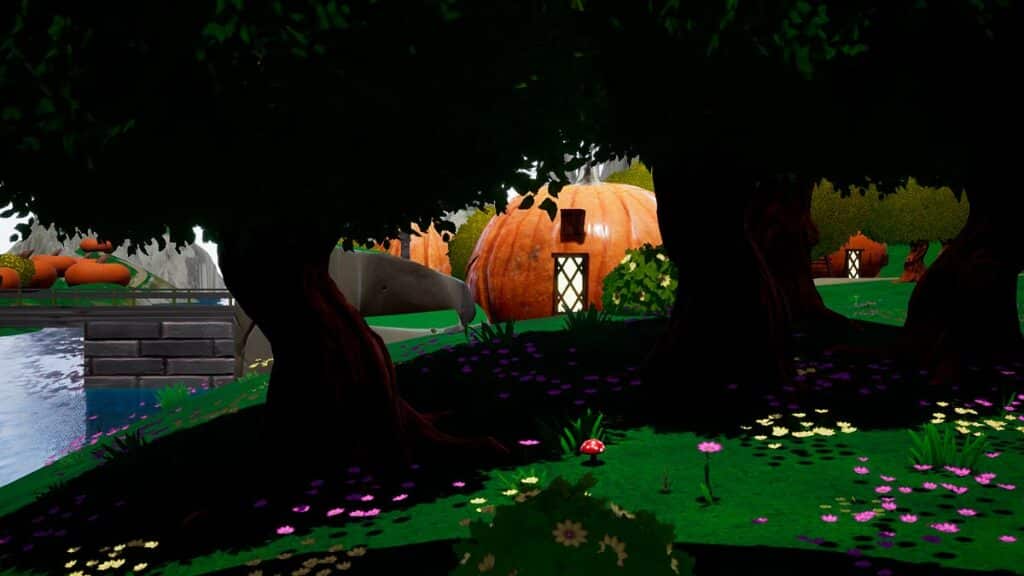Startimes
Stories to read-aloud
Series we start with:
Time for Stars - The Children of Dragomar

Read-aloud age: 4-8
Minimum reading age: 8
Some days it is still light in the evening in Dragomar, and yet it is bedtime. Shortly before, a small conspiratorial community meets in a secret room near the Hall of Books and a colorful toucan reads them little stories from all the books. Except from one book. You can find out how this came about here.
“The Children of Dragomar” forms the frame story, the “hook” to which all the Good Night series tie in, even if they are different in content. So it is easier to meet the possible desire for a new story.
Squash-house Valley

Age for reading aloud: 3-7
Minimum reading age: 6
It’s autumn again. Autumn means harvest time. This would not be unusual if part of the harvest were not pumpkins. Many pumpkins are quite normal but some grow as big as houses. They are wonderful to live in. Every family here lives in a pumpkin. At harvest time, of course, the giant pumpkins stay in their place, which becomes a family’s new plot of land.
All the inhabitants, adults and children help to make the few new giant pumpkins into dwellings.
Friends Pippo, Shania, Georg and Jasemin are vigilant, because the mayor is up to something.
Princess Ayla from the blue islands

Age for reading aloud: 5-8
Minimum reading age: 8
Her real name is Aylamarantanella, royal princess of the House of Vertamares, ruler of the blue islands in the sea of the Horse Kingdom to the horizon and beyond.
Ayla is not even called that when important visitors come. She loves her blue islands in the sea of grass, wild horse, her parents and her grandparents. Grandpa is the king. Ayla’s mother is the daughter of the king and heir to the throne. Ayla’s father is, no one knows for sure, Prince Vandenmeere, once a passing youth who stayed and fell in love with Ayla’s mother.
The stories are about little adventures that two passing children have with Princess Ayla.
Tapsy the clumsy duck

Read-aloud age: 3-7
Minimum reading age: 6
Tapsi is a friendly, still very very young duck. She likes to play with her friends and plunges into every little mess. But with her kindness and her friends she always gets out of it.
Her friends are not only her siblings. They are also the tree frog Halmo, the water turtle Lotti, the stork Gorr the beaver Basis and the raccoon Schmuddel.
Tapsi’s family is not particularly fond of her friends. Especially her big brother, who hatched just one day earlier than Tabs, often raises his bushy eyebrows but he is always there when Tabsi needs him.
The clever rabbit Bommel

Read-aloud age: 3-8
Minimum reading age: 8
What is there to tell about Bommel that he hasn’t already told himself. Peter is a rabbit. Peter tends to exaggerate. When Peter is in trouble, he tells the most adventurous stories. What hardly anyone knows is that the stories are true. This is how Bommel explains big things to very small people.
When the whole rabbit community has to move, even Bommel has his difficulties to find a solution for everything. Winter is coming soon and winter is the time for stories and not the time for digging burrows.
Bommel unexpectedly receives help from two human children. They are siblings who have moved here with their family to the edge of the forest.
About our good night stories that can also be read aloud during the day.
The fact that it always ends well doesn’t mean it has to be boring.
Read aloud time is about 10 to 15 minutes.
How it works:
- Visit Dragomar.net with your smartphone
like to see short info for readers about plot and characters
Select story
Good night stories do not contain sounds or performances. The stories themselves are free of advertising. (Topic advertising: separate information page) In the future we will provide stories in the kids section for self-reading and illustrate them if possible. For kids, however, no text-heaviness on small monitors.we will offer here other, children’s eyes-fair alternatives.
Info for readers
We think it is right and even necessary to point out the content and structure of our stories. It should not be necessary for guardians to be more involved with a read-aloud story than the client – the child. It should not be necessary to go through a text first to see if hate or pseudo-morality has not been subliminally built in there somewhere.
Hence this description below, which is a guide to our storytelling for very young readers and listeners.
Furthermore, we work with independent series, in which the respective basic mood and narrative style does not change. The framework for these stories is the series “The Children of Dragomar”. As with “Sandmännchen”, new stories are introduced in a familiar setting.
Good night stories are small episodes suitable for reading aloud. The plots can be part of a series, which can also involve spatial or content “travel”. Good night stories are written in simple language and exclamations such as “Potzblitz” already represent the borderline of naughtiness. Imagination should be encouraged without disregarding the primary goal, which is a comforting gut feeling.
We do not know to what extent bedtime stories are also suitable for eliminating difficulties in falling asleep. The principle seems to be the same for both children and adults. As with watching television at night from our own experience. If a story is boring, thoughts turn away from the story. If it is new and exciting, you try to stay awake. If the story is well done and you are familiar with the protagonists and know the plot dynamics, you fall asleep well. The task of the person writing and the person reading is a joint one – with one difference that is not. The person writing wants their story to persist against the feeling of falling asleep and to be read to completion. The person reading aloud wants the child to fall asleep gently and have nice dreams. In addition, it is an intense moment of relationship and trust of the person protecting and the person being protected.
Good night stories are disposable
It is what it is. It may be possible to read a story several times because the audience fell asleep early. A story could also be read aloud more than once, but then it would have to fulfill – within 12 minutes – all the factors of a major motion picture. Personal example: watched “The Untouchables” x times, fell asleep x minus 3 times. Why? The first time it was exciting. The second time you look forward to highlights (turning point at the Canadian border with heroic film music, the baby carriage and revolver throwing in slow motion, …), the third time I start to dissect the film and pay attention to technical details (camera, facial expression changes, sequence dynamics). Fact: The film is familiar and it is not a problem to miss something.
We want to achieve something similar with the bedtime stories:
Confidence in the characters.
No problem to miss a story, because the order system is preserved. It shouldn’t happen – after a necessary introduction – that anything changes direction if you miss an episode. Of course, stereotypes are used there. The evil one remains evil. Should he have a good/soft core, this should not be a surprise here. Should nevertheless a good night story be read several times completely and perhaps also help with the first walking attempts in reading, because the action and words are known, we would have succeeded together something beautiful and lasting on if the development of the child passes the stories.
About the contents
There is a guiding framework, a meta-level, to contextualize a plethora of stories. This framework is the children who meet in the library every night, before bedtime.
Cliffhangers
The stories are self-contained without leaving a cliffhanger. The dynamics and structure are based on the abbreviated, classical drama, although the term “drama” should not be dramatized here. What is drama anyway? To a child at play, a cloud in the sky is a cloud. To a 40-person film production team, it can mean shooting failure.
All stories end well.
Terms
In the respective short description, the terms are mentioned, if available, which could lead to questions and it is up to the person reading aloud to evaluate which individual, personal sensitivity level the child has, related to certain terms. Example: “orphan”.
Cultures and Religion
From an educational point of view, no judgmental statements are made about cultures or religions. If one of the actors likes carnival and fireworks, it is made clear that this is an individual perception and no personally motivated socialization influences are made on the part of the narrators. Against our stories, “Good evening, good night” is scary.
Professional groups
No professional group is defamed. No child should be ashamed if a parent is a butcher just because an author is going through his or her vegan struggle phase to lose weight while helping animals, too.
Sexuality
… will not be an issue in the area of reading aloud. With regard to social order principles, it will be briefly pointed out in the respective explanation when stereotypical imaginary worlds are left behind. Example: Family, 2 children, 3 and 6 years old, parents are named Günter and Peter.
In this case, the authors are guided exclusively by the most probable empirical values in the general field of children. In the sebstlesebereich of the “Kids” this can be different, since the socialization and data processing runs off more strongly reflected and if topics are addressed within stories, which are not desired in some society areas or even in states, at least in this respect relativized, as it is not to coin an opinion picture.
Rites, morals, ethics
Rites and morals are part of the systems of order – in stories – as in societies. Ethical principles – neither ethics of mind, nor ethics of duty – are directly conveyed here. Far be it from us to thematize martyrdom and the possible duty to murder tyrants in any way here. In “the light of Dragomar” it looks completely different. There the problems of the world, from different points of view and cultural conditions, are addressed and worked on with a slightly naively whitewashed pen. Here explicitly not.
